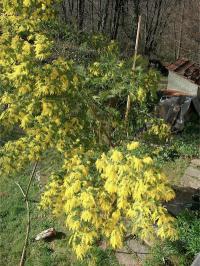Sciaredo is a paradise located at the intersection of planned space and wild nature. The house and garden together make a total work of art.
When the foundation took over the house in 1996, the estate was in a state of chaos. The garden was about to dissolve and the variety of plants had pored out. Apart from the omnipresent and impenetrable brushwood of black currents and lonicera, neophytes like Ailanthus and Laurel had overgrown the paths, the forest, and the acclivities and wide parts of the grassland.
The first 5 years the Sciaredo Association was in charge of the maintenance of the garden and was preoccupied with the task of containing the invasive wilderness. During this work the old structures and plant concepts of Georgette Tentori-Klein became clearer little by little. Through discussions with the people who knew the garden well and by researching GEO’s garden literature as well as photographs, the Sciaredo Association got precious information about Georgette’s concepts. Georgette Tentori-Klein was an engaged gardener, who had planned her garden in a generous and affectionate way. With her husband she also kept a vegetable and fruit garden as well as a vineyard.
Spatial situation
If looking from the front, the yellow cube of the house is a free-standing structure in the area. However, in the back it stands close to the edge of the rock and creates a corridor with it. An old nesbole with a white wisteria on it and a fig tree give a lovely southern-like contrast to the wild vegetation in the back of the house. People reach the house by walking on a path that provides this tension of nature and architecture.
At first the beautifully mossed rock was cleared and the vegetation repelled from the façade of the house. This focus on the topographic parameters makes the rock and the narrow path the backbone of a composition of house and garden.
The garden
Sciaredo invites you to eat and have parties in the open air – with and without guests. In the west and the south of the environs the originally baroque-like circular enclosure was cleared of plants. However, there are no more plant-free areas on which a table could easily be situated. The locale for the tables and the chairs is like a “swimming” island in the middle of the grassland; tangential to the old circular enclosure, generous in its measurements and also slightly cone-shaped, shaded and spatially defined by the kaki tree.
View over the estate
Empty spaces change with the loosely planted ones. Precisely planted decoration trees give the impression of space and mark specific view points. Here and there planted fruit trees give rhythm to the grassland. Bushes and Wild Cherries now form a loose changeover to the forest in the east and filter in winter the sight on the new shoppyland in the valley. By clearing bushes in the west a poplar grove was built.
The paths
Except of the originally with yellow chalk gravelled, now until the last curb with recycling material coated access way and the short concrete path behind the house, the path network consists of dirt trails, mostly abbreviations, that were made accessible. On the west side there is a path along a half deconstructed dry stonewall which marks the border of the property; it probably already existed during the Tentoris time.
The green spaces
Zones landscaped out of necessity contrast with wild growing grassland. These areas are cut piece by piece and on a large scale just before the end of June, in order to keep the biodiversity of flora and fauna, especially the rare glow-worms, the lucole, that give in bright nights of June a magic impression to the garden.
Trees
Decoration trees that go back to the original garden concept give the estate a park-like atmosphere. The two Paulownia trees form a loose, slightly asymmetric, picturesque gate on the way to the house. The mimosa* stands in its original place in front of the west wall and gives the house a southern flair.
Bushes and perennials
Precious single plants change with groups of shrubs and the plantation at the brink of the forest. They offer a smooth transition that adds an additional optical and ecological value to the estate. Great monochrome fields of perennial herbs swim in the green grassland. They comprise the following species; violet crocus and white narcissus in spring, simple lila blue iris, orange daylilies, monbretia and colourful mallows in summer, japan anemones in autumn.
Brigitte Stadler, Sciaredo Association (Translation: Annelise Zwez/Olga Stefan)
* unfortunately the original mimosa fell in 2012 during a storm, but from the roots new sprouts come up
| Attachment | Size |
|---|---|
| 513.71 KB |





